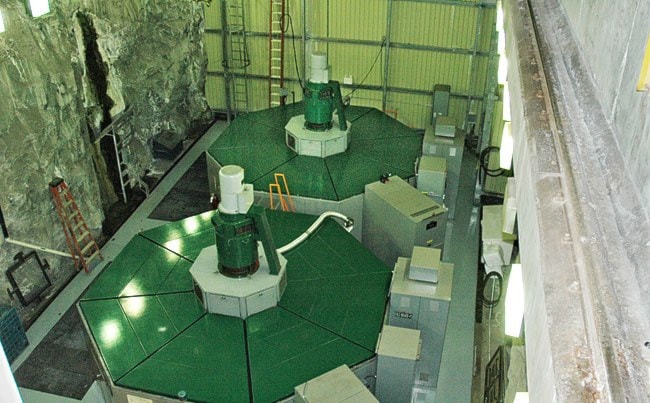The Champagne and Aishihik First Nations don’t support Yukon Energy’s Gladstone proposal.
For the last few years, the utility has been researching the possibility of diverting water from the Gladstone chain of lakes into the Sekulmun-Aishihik Lake system, to produce up to 18 gigawatt hours of electricity annually using the turbines at the Aishihik hydro facility.
“It’s very controversial for our people,” said Chief James Allen on Monday.
“And I have not met anyone who supports it.”
Allen is worried about “environmental damage and the impact on wildlife that uses the area.
“And the impact to fish.”
Redirecting one watershed into another could transfer diseases and pathogens, he said.
The Department of Fisheries and Oceans is worried about the same thing.
Its report, dated September 30, puts the kibosh on Gladstone.
“Due to the significance of the potential impacts to fish and fish habitat, Fisheries and Oceans is not prepared to consider a Fisheries Act authorization for your proposal at this time,” it states.
But Yukon Energy president David Morrison is still hopeful.
And he’s continuing to study Gladstone.
“Fisheries and Oceans hasn’t looked at the science,” said Morrison.
“It was just a preliminary letter.”
The diseases and pathogens in each watershed are the same, so transferring them isn’t a risk, said Morrison.
“We have fisheries experts doing this work.”
Yukon Energy sent Fisheries and Oceans the results of its aquatic studies.
But Fisheries and Oceans still wasn’t convinced.
At the end of February, it sent Morrison another letter.
“Fisheries and Oceans remains concerned that the proposed Gladstone concept will result in significant impacts to fish and fish habit,” it states.
Champagne and Aishihik are allowing Yukon Energy to continue studying Gladstone.
“It’s good to gather information about different areas in our traditional territory,” said Allen.
“So we’ve agreed to these studies to add to our traditional knowledge.
“But these studies are in no way to allow Gladstone,” he said.
On Monday, Yukon Energy signed “a protocol agreement” with Champagne and Aishihik and the Dakwakada Development Corporation.
“It’s mainly to open the doors to set up a working relationship with Yukon Energy,” said Allen.
“We want to work together to develop renewable energy.”
Champagne and Aishihik are looking at geothermal and biomass possibilities.
“We have all these spruce beetle-kill trees,” said Allen.
The First Nations also have a valley that has good wind potential, he said.
Gladstone has nothing to do with signing this agreement, added Allen.
Yukon Energy hopes to sign similar agreements with all Yukon First Nations, said Patterson.
“It’s a fairly new approach for Yukon Energy,” she said.
“We’ve always talked to First Nations about specific issues, but these are more general discussions.”
The agreement with Champagne and Aishihik happened first because “we’ve been working with them on a lot of projects, like Gladstone,” said Patterson.
This agreement is not about Gladstone, said Allen.
“No matter what, Gladstone is a no,” he said.
But Yukon Energy isn’t giving up.
If the First Nations “say no, it will be difficult to move forward,” said Morrison.
“But we’re not there yet, we’re still in the study phases.
“We have to finish the science first, the same as Atlin.”
For the last few years, Yukon Energy has been considering holding Atlin Lake at seasonal highs for months longer than normal, to help generate 18 gigawatts of additional power.
It has spent more than $3 million studying the impacts this would have on fish, ice, shoreline and wildlife.
But Yukon Energy didn’t study BC’s Park Act.
Atlin Lake is “a Class A park,” says a letter from BC Environment Minister Murray Coell, dated November 25.
According to the park act, “water is a natural resource,” wrote Coell.
“If a natural resource in a Class A park will be disturbed, damaged or exploited ... the proponent would need authorization by way of a park-use permit.”
Yukon Energy doesn’t have such a permit.
And, according to Coell, it’s not likely to get one.
“A park-use permit may only be issued ... if the proposed activity is necessary for the preservation or maintenance of the recreational values of the park,” he wrote.
“If this requirement cannot be satisfied, a park use permit to change the water levels of Atlin Lake will not be issued.”
Raising Atlin Lake’s water levels does not appear to “preserve or maintain the recreational values of the park.”
In fact, “It appears that a natural resource in a Class A park will be disturbed or exploited,” wrote Coell.
Yukon Energy “doesn’t know if this is an issue or not,” said Patterson.
“We are trying to get clarity on whether we’d need a park permit or not.”
Yukon Energy is still hopeful about both its Gladstone and Atlin proposals.
“There are no show-stoppers yet,” said Morrison.
Contact Genesee Keevil at
gkeevil@yukon-news.com
